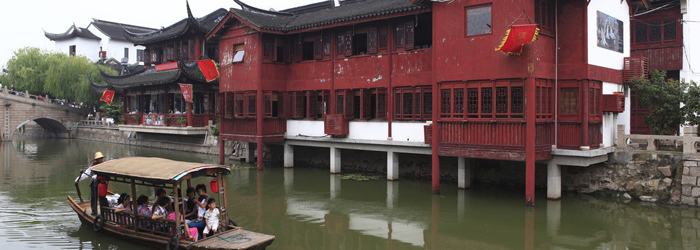About ShanghaiAttractions Conference Map External Links |
Xujiahui FengjingWith a history of more than 1,500 years, Fengjing ancient town was once a key connection between Jiangsu and Zhejiang provinces. There are many bridges, temple, famous people and lanes in the town. The town is also known as the birthplace of the famed Jinshan Peasant Painting, which has won praise for its creative designs and bright colors that vividly represent the everyday life of the working people.QibaoThere is a 360-m long south-north boulevard in the center of Qibao ancient town. The North Square and the Bridge-head Square are the principal parts.ZhujiajiaoKnown as the “ Venice in Shanghai ”, it is a well-preserved waterside ancient town. It was already a country fair as early as the Warring States Period, 1,700 years ago. During the Wanli years of the Ming Dynasty (1573-1617), with merchants flocking to the place and a growing population, it had become a prosperous town. There, we can still see the traces of the antique markets and streets of the Ming and Qing Dynasties. The antique buildings and simple life-style of the town's people will give visitors a feeling of peace and rest.NanxiangNanxiang has a history of nearly 1500 years. It's a business center from old times and was known as Silver Nanxiang. In 1991, it was listed as one of the four famous historical and cultural towns in Shanghai.Dianshan LakeThe 62-square-kilometer lake has earned its reputation as “Lake Geneva of the East”. Bordering on the provinces of Jiangsu and Zhejiang, it is part of the Taihu Lake system.NanxunNanxun, just west of Shanghai, is one of southern China 's famous water towns with courtyard houses lining narrow streets, and canals crossed by stone bridges.WuzhenWuzhen, a town with a history of 1200 years, is just 50 minutes' drive from Hangzhou City . This small town, with its black tiled, tung oilpainted timber framework houses, that contrast sharply with its white walls and gray flagging, brings to mind a Chinese ink and wash painting. The river running through the town was once the main means of transportation for local people, but these days is little used, other than for festive celebrations, when bulk cargo is shipped in. The window sills of the houses on the banks of the river are further extended with boards, on which flowers, plants and bonsai bloom in the warm sunshine, adding a touch of life and color to this tranquil, old-style town.XitangXitang is level, densely distributed with rivers and has a very quiet natural environment.9 rivers converge in this town, dividing it into 8 sections, but many bridges link this water town together(anciently called as “nine dragon old pearl” and “wind from 8 sides”).Inside the town, there are many well-preserved architectural groups constructed during the Ming and Qing dynasties, which boast a higher artistry and study value, thus being highlighted by the experts at home and abroad studying antique buildings. Through a bird's-eye view of the whole town, green waves ripple everywhere and every family resides near water. In the morning, water flows beneath bridges, thin mist is like silk, pinkish walls on both banks stand tall and erect and tiled houses are reflected inversely in the water. In the evening, the setting sun shines slantwise, songs come from fishing boats, lamps flicker and the fragrance of wine drifts. The whole old town is like a poem and a picture. In this town, people will feel that they are seemingly in an earthly paradise. It is hard to know that people exist in the picture or picture exists in the heart of people.TongliTongli, a picturesque and elegant town, has become world-known for its having wonderful scenery, classic building and precious relics.LuzhiThe history of Luzhi dated back 2500 years ago when King of Wu during the Spring and Autumn Period built his palace north of the town. From Tang dynasty through Ming and Qing, many man of letters lived in this dreamland water town. |

 Abstract Template
Abstract Template Abstract Template
Abstract Template